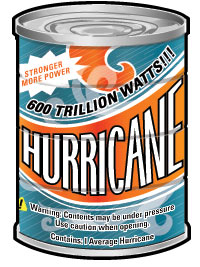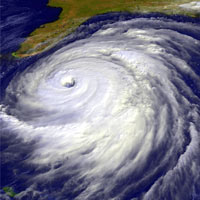



The heat engine known as Hurricane Floyd, in a NASA image |
Hurricane PowerFact: The total energy released through cloud and rain formation in an average hurricane is equivalent to 200 times the worldwide electrical generating capacity. This astonishing fact comes by way of Christopher Landsea, a hurricane expert with the National Oceanic and Atmospheric Administration. But how can atmospheric scientists possibly know how much energy a hurricane gives off? Obviously there's no thermometer big enough to measure the heat energy of a urikan, or "big wind," as the Carib Indians who gave us the word knew them. First you have to know how much rain comes down in your average hurricane (never mind why for the moment). For over 2,000 years, people measured rainfall with rain gauges. But bowls placed in the rain won't cut it for a hurricane. Fortunately, weather radars can. By bouncing electromagnetic radiation off rain or ice and calculating how much energy is returned, radars can give fairly accurate estimates of rainfall rates. A weather radar aboard the Tropical Rainfall Measuring Mission satellite can now do this across an entire hurricane. Now for a few calculations. In 1981, William Gray, the nation's leading hurricane forecaster, published a paper stating that an average hurricane produces a little over half an inch of rain a day within a circular area 825 miles across. If you convert this to a volume of rain, Landsea notes, you get about 1.3 x 1015 cubic inches a day. That's enough rain to fill over 22 million Olympic-sized swimming pools! Now, to figure how much energy is discharged when all that rain is produced, you have to use the so-called "latent heat of condensation." When water vapor cools sufficiently, it condenses into water droplets. Think of a cold can of soda on a hot day: water droplets appear on the outside because the thin layer of air surrounding the can is being cooled enough that all the water vapor in that layer condenses out. During that condensation process, it turns out, latent (stored) heat is given off. When tropical meteorologists calculate using the latent heat of condensation, they find that the condensation of those 22 million Olympic pools worth of rain results in the release of 600 trillion watts of heat energy—or 200 times the worldwide electrical generating capacity as of January 1, 1996, according to U.S. Department of Energy figures. Fortunately for those in the path of hurricanes, most of this energy goes into generating the storm's rising motions or gets expelled as a kind of "cold exhaust" in the upper layers of the atmosphere, some eight or ten miles up. Only a tiny portion of that total energy goes into cooking up the ferocious winds. "A hurricane is a pretty inefficient heat engine," Landsea says. "Only about a half percent of all the energy that's being released is actually captured by the hurricane to warm the air locally, lower the pressure, and spin the winds out."
Yet as people in, say, Florida know all too well, that half percent still packs
a wallop. Like 1,500,000,000,000 watts in the average hurricane—or fully
half of the global electrical output.—Peter Tyson
|
|
|||||||||
|
|
|||||||||||
|
© | Created January 2005 |
|||||||||||